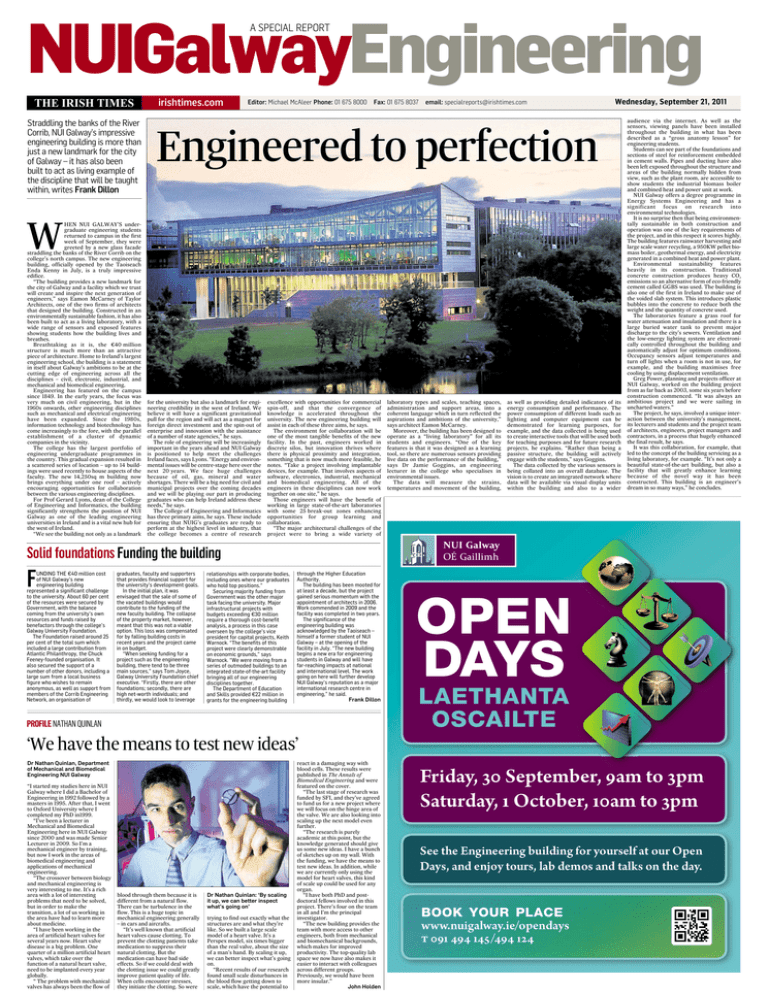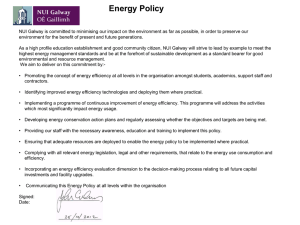Open Days
advertisement

NUIGalwayEngineering A SPECIAL REPORT THE IRISH TIMES Straddling the banks of the River Corrib, NUI Galway’s impressive engineering building is more than just a new landmark for the city of Galway – it has also been built to act as living example of the discipline that will be taught within, writes Frank Dillon irishtimes.com Editor: Michael McAleer Phone: 01 675 8000 Fax: 01 675 8037 email: specialreports@irishtimes.com Wednesday, September 21, 2011 Engineered to perfection W HEN NUI GALWAY’S undergraduate engineering students returned to campus in the first week of September, they were greeted by a new glass facade straddling the banks of the River Corrib on the college’s north campus. The new engineering building, officially opened by the Taoiseach Enda Kenny in July, is a truly impressive edifice. “The building provides a new landmark for the city of Galway and a facility which we trust will create and inspire the next generation of engineers,” says Eamon McCarney of Taylor Architects, one of the two firms of architects that designed the building. Constructed in an environmentally sustainable fashion, it has also been built to act as a living laboratory, with a wide range of sensors and exposed features showing students how the building lives and breathes. Breathtaking as it is, the ¤40 million structure is much more than an attractive piece of architecture. Home to Ireland’s largest engineering school, the building is a statement in itself about Galway’s ambitions to be at the cutting edge of engineering across all the disciplines – civil, electronic, industrial, and mechanical and biomedical engineering. Engineering has featured on the campus since 1849. In the early years, the focus was very much on civil engineering, but in the 1960s onwards, other engineering disciplines such as mechanical and electrical engineering have been expanded. Since the 1980s, information technology and biotechnology has come increasingly to the fore, with the parallel establishment of a cluster of dynamic companies in the vicinity. The college has the largest portfolio of engineering undergraduate programmes in the country. This gradual expansion resulted in a scattered series of location – up to 14 buildings were used recently to house aspects of the faculty. The new 14,250sq m building now brings everything under one roof – actively encouraging opportunities for collaboration between the various engineering disciplines. For Prof Gerard Lyons, dean of the College of Engineering and Informatics, the building significantly strengthens the position of NUI Galway as one of the leading engineering universities in Ireland and is a vital new hub for the west of Ireland. “We see the building not only as a landmark for the university but also a landmark for engineering credibility in the west of Ireland. We believe it will have a significant gravitational pull for the region and will act as a magnet for foreign direct investment and the spin-out of enterprise and innovation with the assistance of a number of state agencies,” he says. The role of engineering will be increasingly important in the years ahead and NUI Galway is positioned to help meet the challenges Ireland faces, says Lyons. “Energy and environmental issues will be centre-stage here over the next 20 years. We face huge challenges because of oil, gas, mineral and water shortages. There will be a big need for civil and municipal projects over the coming decades and we will be playing our part in producing graduates who can help Ireland address these needs,” he says. The College of Engineering and Informatics has three primary aims, he says. These include ensuring that NUIG’s graduates are ready to perform at the highest level in industry, that the college becomes a centre of research excellence with opportunities for commercial spin-off, and that the convergence of knowledge is accelerated throughout the university. The new engineering building will assist in each of these three aims, he says. The environment for collaboration will be one of the most tangible benefits of the new facility. In the past, engineers worked in discrete silos, but innovation thrives where there is physical proximity and integration, something that is now much more feasible, he notes. “Take a project involving implantable devices, for example. That involves aspects of software, electronics, industrial, mechanical and biomedical engineering. All of the engineers in these disciplines can now work together on one site,” he says. Those engineers will have the benefit of working in large state-of-the-art laboratories with some 25 break-out zones enhancing opportunities for group learning and collaboration. “The major architectural challenges of the project were to bring a wide variety of laboratory types and scales, teaching spaces, administration and support areas, into a coherent language which in turn reflected the aspirations and ambitions of the university,” says architect Eamon McCarney. Moreover, the building has been designed to operate as a “living laboratory” for all its students and engineers. “One of the key features is that it was designed as a learning tool, so there are numerous sensors providing live data on the performance of the building,” says Dr Jamie Goggins, an engineering lecturer in the college who specialises in environmental issues. The data will measure the strains, temperatures and movement of the building, as well as providing detailed indicators of its energy consumption and performance. The power consumption of different loads such as lighting and computer equipment can be demonstrated for learning purposes, for example, and the data collected is being used to create interactive tools that will be used both for teaching purposes and for future research projects, he explains. “Rather than being a passive structure, the building will actively engage with the students,” says Goggins. The data collected by the various sensors is being collated into an overall database. The vision is to create an integrated network where data will be available via visual display units within the building and also to a wider audience via the internet. As well as the sensors, viewing panels have been installed throughout the building in what has been described as a “gross anatomy lesson” for engineering students. Students can see part of the foundations and sections of steel for reinforcement embedded in cement walls. Pipes and ducting have also been left exposed throughout the structure and areas of the building normally hidden from view, such as the plant room, are accessible to show students the industrial biomass boiler and combined heat and power unit at work. NUI Galway offers a degree programme in Energy Systems Engineering and has a significant focus on research into environmental technologies. It is no surprise then that being environmentally sustainable in both construction and operation was one of the key requirements of the project, and in this respect it scores highly. The building features rainwater harvesting and large scale water recycling, a 950KW pellet biomass boiler, geothermal energy, and electricity generated in a combined heat and power plant. Environmental sustainability features heavily in its construction. Traditional concrete construction produces heavy CO2 emissions so an alternative form of eco-friendly cement called GGBS was used. The building is also one of the first in Ireland to make use of the voided slab system. This introduces plastic bubbles into the concrete to reduce both the weight and the quantity of concrete used. The laboratories feature a grass roof for water attenuation and insulation and there is a large buried water tank to prevent major discharge to the city’s sewers. Ventilation and the low-energy lighting system are electronically controlled throughout the building and automatically adjust for optimum conditions. Occupancy sensors adjust temperatures and turn off lights when a room is not in use, for example, and the building maximises free cooling by using displacement ventilation. Greg Power, planning and projects officer at NUI Galway, worked on the building project from as far back as 2003, some six years before construction commenced. “It was always an ambitious project and we were sailing in uncharted waters.” The project, he says, involved a unique interaction between the university’s management, its lecturers and students and the project team of architects, engineers, project managers and contractors, in a process that hugely enhanced the final result, he says. It was this collaboration, for example, that led to the concept of the building servicing as a living laboratory, for example. “It’s not only a beautiful state-of-the-art building, but also a facility that will greatly enhance learning because of the novel way it has been constructed. This building is an engineer’s dream in so many ways,” he concludes. Solid foundations Funding the building F UNDING THE ¤40 million cost of NUI Galway’s new engineering building represented a significant challenge to the university. About 60 per cent of the resources were secured by Government, with the balance coming from the university’s own resources and funds raised by benefactors through the college’s Galway University Foundation. The Foundation raised around 25 per cent of the total sum which included a large contribution from Atlantic Philanthropy, the Chuck Feeney-founded organisation. It also secured the support of a number of other donors, including a large sum from a local business figure who wishes to remain anonymous, as well as support from members of the Corrib Engineering Network, an organisation of graduates, faculty and supporters that provides financial support for the university’s development goals. In the initial plan, it was envisaged that the sale of some of the vacated buildings would contribute to the funding of the new faculty building. The collapse of the property market, however, meant that this was not a viable option. This loss was compensated for by falling building costs in recent years and the project came in on budget. “When seeking funding for a project such as the engineering building, there tend to be three main sources,” says Tom Joyce, Galway University Foundation chief executive. “Firstly, there are other foundations; secondly, there are high net-worth individuals; and thirdly, we would look to leverage relationships with corporate bodies, including ones where our graduates who hold top positions.” Securing majority funding from Government was the other major task facing the university. Major infrastructural projects with budgets exceeding ¤30 million require a thorough cost-benefit analysis, a process in this case overseen by the college’s vice president for capital projects, Keith Warnock. “The benefits of this project were clearly demonstrable on economic grounds,” says Warnock. “We were moving from a series of outmoded buildings to an integrated state-of-the-art facility bringing all of our engineering disciplines together. The Department of Education and Skills provided ¤22 million in grants for the engineering building through the Higher Education Authority. The building has been mooted for at least a decade, but the project gained serious momentum with the appointment of architects in 2006. Work commended in 2009 and the facility was completed in two years. The significance of the engineering building was acknowledged by the Taoiseach – himself a former student of NUI Galway – at the opening of the facility in July. “The new building begins a new era for engineering students in Galway and will have far-reaching impacts at national and international level. The work going on here will further develop NUI Galway’s reputation as a major international research centre in engineering,” he said. Frank Dillon PROFILE NATHAN QUINLAN ‘We have the means to test new ideas’ Dr Nathan Quinlan, Department of Mechanical and Biomedical Engineering NUI Galway “I started my studies here in NUI Galway where I did a Bachelor of Engineering in 1992 followed by a masters in 1995. After that, I went to Oxford University where I completed my PhD in1999. “I’ve been a lecturer in Mechanical and Biomedical Engineering here in NUI Galway since 2000 and was made Senior Lecturer in 2009. So I’m a mechanical engineer by training, but now I work in the areas of biomedical engineering and applications of mechanical engineering. “The crossover between biology and mechanical engineering is very interesting to me. It's a rich area with a lot of interesting problems that need to be solved, but in order to make the transition, a lot of us working in the area have had to learn more about medicine. “I have been working in the area of artificial heart valves for several years now. Heart valve disease is a big problem. One quarter of a million artificial heart valves, which take over the function of a natural heart valve, need to be implanted every year globally. “ The problem with mechanical valves has always been the flow of blood through them because it is different from a natural flow. There can be turbulence in the flow. This is a huge topic in mechanical engineering generally – in cars and aircrafts. “It’s well known that artificial heart valves cause clotting. To prevent the clotting patients take medication to suppress their natural clotting. But the medication can have bad side effects. So if we could deal with the clotting issue we could greatly improve patient quality of life. When cells encounter stresses, they initiate the clotting. So were Dr Nathan Quinlan: ‘By scaling it up, we can better inspect what’s going on’ trying to find out exactly what the structures are and what they’re like. So we built a large scale model of a heart valve. It’s a Perspex model, six times bigger than the real valve, about the size of a man’s hand. By scaling it up, we can better inspect what’s going on. “Recent results of our research found small scale disturbances in the blood flow getting down to scale, which have the potential to react in a damaging way with blood cells. These results were published in The Annals of Biomedical Engineering and were featured on the cover. “The last stage of research was funded by SFI, and they’ve agreed to fund us for a new project where we will focus on the hinge area of the valve. We are also looking into scaling up the next model even further. “The research is purely academic at this point, but the knowledge generated should give us some new ideas. I have a bunch of sketches up on my wall. With the funding, we have the means to test new ideas. In addition, while we are currently only using the model for heart valves, this kind of scale up could be used for any organ. “I have both PhD and postdoctoral fellows involved in this project. There’s four on the team in all and I’m the principal investigator. “The new building provides the team with more access to other engineers, both from mechanical and biomechanical backgrounds, which makes for improved productivity. The top-quality lab space we now have also makes it easier to interact with colleagues across different groups. Previously, we would have been more insular.” John Holden Open Days Laethanta OscaiLte Friday, 30 September, 9am to 3pm Saturday, 1 October, 10am to 3pm See the Engineering building for yourself at our Open Days, and enjoy tours, lab demos and talks on the day. book your place www.nuigalway.ie/opendays t 091 494 145/494 124

